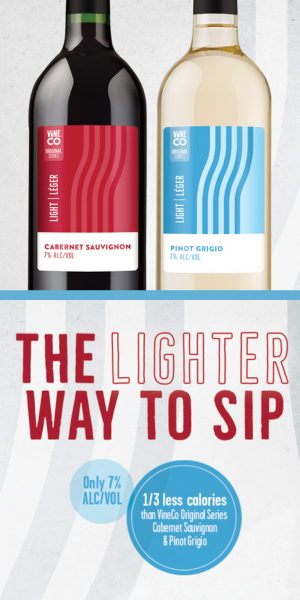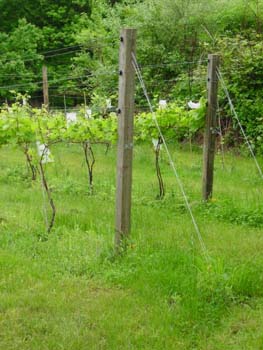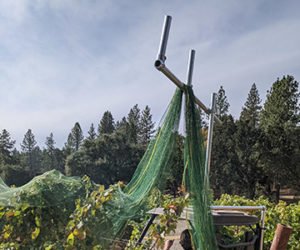 Galileo is credited with the quote: “Wine is sunlight held together by water.” It’s one of my favorite quotes in the wine world because it’s so simple. In nature, a vine has one purpose: Use sunlight and water to parasitize a tree in a forest, steal the tree’s light, and use the structure of the tree to get into the sunlight to use the sun’s energy to produce sweet grapes to attract animals that will disperse the seeds through consumption and defecation. Let’s assume you have enough sunlight in your backyard to get a vine to grow and produce fruit sweet enough to make wine. Now we just have to make sure that the vine has just enough water to do its job.
Galileo is credited with the quote: “Wine is sunlight held together by water.” It’s one of my favorite quotes in the wine world because it’s so simple. In nature, a vine has one purpose: Use sunlight and water to parasitize a tree in a forest, steal the tree’s light, and use the structure of the tree to get into the sunlight to use the sun’s energy to produce sweet grapes to attract animals that will disperse the seeds through consumption and defecation. Let’s assume you have enough sunlight in your backyard to get a vine to grow and produce fruit sweet enough to make wine. Now we just have to make sure that the vine has just enough water to do its job.
In most non-desert areas of North America, irrigation will not be necessary to produce ripe fruit in a backyard vineyard. As explained later, if your home receives 20–25 inches (51–64 cm) of rain per year, you may be able to “dry farm” your grapes, saving the cost of establishing an irrigation system, but you may want to have some extra hose around just in case those vines need a rare drink in an extended dry, hot spell. The Eurasian grapevine requires relatively little water to produce a bottle of wine. Even in California, about 5–6 gallons (19–23 L) of water will historically produce a bottle of wine in arid conditions (12 inches/30 cm of rain). Compare this to 400 gallons/~1,520 L for a pound of beef or about 50 gallons/190 L for a single egg! With that in mind, let’s take a close look at irrigating the home vineyard so we can make a smart decision on if you need to provide supplemental irrigation, and if you do, how and when to best apply it.
To start, let’s go over some common myths and then I’ll give you some ideas on how to install an irrigation system for your home vineyard if it is necessary. It takes much more space than this story is allotted to offer all of the technical expertise to design and implement an entire irrigation system, but this article is meant to define the different types of irrigation so you can choose a style to fit your backyard vineyard. Installation can be researched further in books or on the internet, and most landscape design companies can help you size the pipes, valves, and pumps that may be necessary.
Now, let’s go over some of the most common myths about irrigation.
1. Stressing grapevines always produces superior fruit. Healthy, mature grapevines produce the best fruit. There are regions in the world (the Rhône Valley of France comes to mind) where stressed vines on rocky hillsides produce intense, ripe fruit that makes beautiful wine. But let’s put that aside for now, because we do not live in those places. My plan for your vineyard has little to do with stress. Let’s focus on keeping the vines healthy, viable, and alive. Sugar is produced by healthy, green leaves turning sunlight, water and nutrients into fruit. Stressed vines are more susceptible to disease, mildew and rot. The old adage about stressing the vine is pure mythology in the New World, so erase it from your head.
2. Growing regions that require irrigation are inferior. Winegrape growing regions in the world that get adequate rainfall as to make irrigation unnecessary often espouse their superiority over arid areas that require supplemental water. The Willamette Valley of Oregon is one of those places, a region that loves to compare itself to the Côte d’Or in Burgundy. But even the Oregonians commonly irrigate young vineyards now, to make sure that their investment in young vines matures into a producing vineyard. Arid areas that commonly receive less than 10 inches (25 cm) of rainfall a year (such as Eastern Washington State) clearly show that irrigation-dependent areas can produce stunning wines of world-class quality.
3. No water before harvest always improves wine quality. Letting the ground dry out will certainly hasten sugar accumulation, but most of the ‘Brix bump’ is due to dehydration, NOT the evolution of phenolic ripeness. For those interested in making high-octane, monster wines, this technique may get them the concentration they are looking for, but as an individual who likes wines with balanced fruit, alcohol, and acidity, I’m a big proponent of allowing the vine to keep green leaves through harvest. This keeps the vine from dehydrating the fruit, and a viable, live vine continues to ripen fruit naturally without dehydration.
4. Clay soils need to be irrigated more than sandy soils. The opposite is true: Clay holds water much longer than sand, so clay soils actually require significantly less irrigation. Clay absorbs water, while sand allows it to drain. Most soils are a mix of sand, loam, and clay.
5. Mature grapevines compete with weeds for water and nutrients. Actually, most vines absorb water and nutrients from deep in the soil profile, and do not compete directly with weeds. Weeds can compete for irrigation water that is applied sparingly, as it does not reach the appropriate depth for the vines’ root system. Weeds are competitive with young vines, though, and should never be allowed to grow into the canopy.
6. An irrigation system for a vineyard requires expensive equipment.
An irrigation system is as easy or as expensive as you want to make it. If you can get by with using a hose and applying the water by hand, all the power to you! The only reason to drop serious money on an irrigation system is convenience and an increase in fruit and wine quality. More on this later.
7. All vineyards require irrigation. If your vines stay viable and green throughout the growing season without supplemental irrigation, consider yourself blessed. Don’t pay for what you don’t need!
8. Vines cannot tell the difference between rain and irrigation. Rainwater is far superior to ground or municipal water for irrigation. Municipal water often contains chlorine or fluoride byproducts (often from steel, uranium, and aluminum manufacturing), which are not needed for healthy growth, and can actually be harmful to the vines. Have your water tested by an agricultural lab to make sure it is usable for vineyard irrigation.
9. Water is best applied right under the vine. Not true! If you are using drip line and drip emitters, spread them out so the vines have to spread out their roots to find water. You do not want the vines to make a single rootball at the base of the trunk and become dependent and lazy on the drip emitters. If the vine has equidistant drip emitters on either side, it will spread its root system out.
10. The best time to install irrigation is after the trellising is installed.
Don’t do it! The first thing to be installed in a vineyard project is the layout and irrigation. Make sure the irrigation is fully functional before putting in trellising and vines. Remember that at least half of a good irrigation system is underground, and you may have to trench across the rows.
Do I Need an Irrigation System?
Can vineyards in your locale produce good fruit year in and year out with normal rainfall patterns (i.e. no irrigation)? Answering this question may require some research and outreach to local vineyardists. I can’t stress how important it is to do this type of study. Every hour you spend with folks growing in your area will save you hundreds of hours in fixing mistakes that could have been avoided. If you determine that locals do NOT use irrigation, your vineyard establishment costs will be drastically reduced. If it appears that irrigating vines is the standard, ask questions like: How did you set up your irrigation system? Do you use furrow, sprinklers, or drip irrigation? How much water do you apply at various times of the year? How much did the system cost and where did you order the parts? Try to visit at least three different vineyards, ask a lot of questions, take notes, taste their wines as a reference.
Another option is to monitor your soil’s moisture on a weekly basis with a device such as a soil moisture probe or Irrometer. Knowing how much water is at root level (2–5 feet/60–150 cm) will help you make decisions based on real time measurement. When the soil is dry at that depth, irrigate until it is saturated and then let it dry out again before watering.
The basic systems
Here are the three basic irrigation systems for vineyards. They are listed from least expensive to most costly.
1. Surface or furrow irrigation: This is simple stuff. Using a hoe, a shovel, or other tool, cut a furrow down the vine row, right next to the trunks of the vines. With a hose, run water from the top of the furrow (elevated side if there is one) until the whole furrow is flooded, and the water begins to move through the soil and is usable by the vines. Benefits include low cost of installation, no sprinkler water on vines and fruit (leads to disease), good control of soil salinity, some frost protection and the application is not sensitive to wind. The negatives include that this method is not effective on hillsides above 2–5% slope, low irrigation efficiency (a lot of water is used), and berms and furrows must be maintained, which is labor intensive.
2. Sprinklers: Permanent sprinklers are installed on risers that are at least a few feet above the vines. Sprinklers rain down water on the whole vineyard. Generally, the sprinklers will be affixed to existing trellis stakes, and will extend above where you anticipate the canopy to grow. The pros of this system include frost and heat suppression, better on shallow soils, keeps dust and dust mites under control, and it can be automated. The cons are a high initial cost, will increase bunch rot and mildew pressure significantly, and the required maintenance of sprinkler heads and system.
3. Drip irrigation: There’s a reason why 90%+ of commercial vineyard installations choose drip irrigation. During installation a ditch is cut perpendicular to the vine rows and PVC pipe is installed down the center of the vineyard and is buried. Stubs are created for every vine row, and ‘t’ sections are attached to 1⁄2-inch irrigation tubing that is suspended from a low trellis wire. Drip emitters are punched into the system, the ends of the tubing are crimped and secured, the system is charged with pressure, and the drippers begin to apply water very accurately and efficiently. The benefits of drip irrigation are clear: Efficient and easy to control vine water status, useful on steep slopes (steep slopes should use 0.5 gallon/2 L an hour emitters, while gentle and flat vineyards can use 1 gallon/4 L), can irrigate late in season, and they can be automated.However, drip irrigation is expensive to install, has no frost control and the emitters and system need to be cleaned to prevent clogging.
Oh, the Pressure!
Your sprinkler or drip system will require a minimum pressure in the system to be effective. Sprinklers are placed at a distance that will give complete coverage, and you may find that the pressure needs to be increased with a pump in order to get full coverage. Try to oversize the pump slightly, as having extra pressure is always better than having too little. Remember that the pressure will increase at the bottom of a slope, and reduce up the slope from the pump. Size the pump to pressurize the highest sprinkler to a pressure that gives good coverage, and the bottom should take care of itself. On the drip side, make sure to use pressure-compensating drip emitters (I prefer Netafim brand), so a uniform amount of water will be applied between 10 PSI and 60 PSI (a nice wide range). You may be able to get away with attaching a standard backyard hose bib to your drip system as long as the pressure throughout the system stays in the above range and adequate irrigation is achieved.
Irrigating
So, how much water should you apply and when should your system be turned on? Of course the answer is site specific, and the answer will vary according to the following factors:
Soil Type: Clay retains more water than sand. Clay soils hold water a long time and will require less irrigation and you may be able to wait until late spring early summer to start putting water down. Sandy soils drain quickly and require more water and frequent applications. Soils at Clos Pepe Vineyards in the Santa Rita Hills of California are very sandy, and we usually started applying 4–7 gallons (15–27 L) per week per vine in April or May, and continued to apply a similar amount until after fruit softening.
Furrow Irrigation: When the ground is dry and the vines need irrigation, a deep weekly or twice monthly furrow irrigation may give the vines all the water they need.
Sprinkler Irrigation: When vines need supplemental irrigation, start with a three- or four-hour sprinkle once a week and see how the vines react. Increase in warm weather, and decrease in cool weather. Pay special attention to mildew and rot, and realize that weed growth will also increase between vine rows. Sprinklers are also a great way to start your cover crop growing after harvest.
Drip Irrigation: When the soil is dry, apply 2–7 gallons (8–27 L) of water via drip emitters per week. Watch the growth of the vines carefully to make sure the vines are not stunted (too little water/nutrients) or overly vigorous (too much water/nutrients). Reduce water after bloom until set, and also reduce water just before harvest, but keep the vine viable with some green leaves through picking.
Post-Harvest Irrigation: Vines need a deep drink after harvest. There’s nothing wrong with providing each vine 10–20 gallons (38–76 L) after harvest to help the vine root deeply (a period of rapid root growth follows harvest).
More water in the heat, less in cool weather: Growing grapevines are constantly taking up water and nutrients and respiring water vapor from their leaves. In hot weather, they are using much more water, and consequently you need to increase irrigation. In cool, foggy, and windy weather, water use is drastically reduced, and a corresponding reduction of irrigation is appropriate.
Go get wet (or not)
Hopefully I’ve given you some things to think about to make an informed decision about irrigation. Be sure to arm yourself with information from local grape growers about your microclimate to be sure you need to irrigate in the first place.
A Short Treatsie on Drought (sidebar)
Many areas in California and the United States West Coast are still under severe drought conditions, as are other grape growing regions around the globe. Here are a few additional considerations for using irrigation in areas impacted by low rainfall totals:
• Your root systems will be impacted by salt accumulation. Adding ground water to a vineyard adds salts to the soil profile, while rain washes them away. Without 15–20 inches (38–51 cm) of seasonal rainfall at last every 3–5 years, your vines will start showing symptoms of saline soil — burned margins on the leaves, vines shutting down early, lower fruitfulness and reduced wine quality.
• In drought conditions, where water has become precious, use best practices to guarantee the best irrigation efficiency for every drop. Never use sprinkler irrigation; drip irrigation or sub-soil application are always best, and always irrigate in the cool of night.
• You may be surprised how water-efficient vines can be. If your leaves are not drooping, (90 degree angle between stem (petiole) and leaf blade is optimal) and the vine’s tendrils are still reaching out past the growing tip, you can hold off on watering. Vines respond quickly to irrigation after showing water stress, so in those drought-stricken areas, watch the vine for symptoms of slight water stress before using precious water resources.
• The longer you grow grapes and the more you walk the vineyard and observe, the better you will become at fine-tuning the water needs of your vines. Old vines may have deeper roots and more ability to draw water from deeper in the
soil profile.







